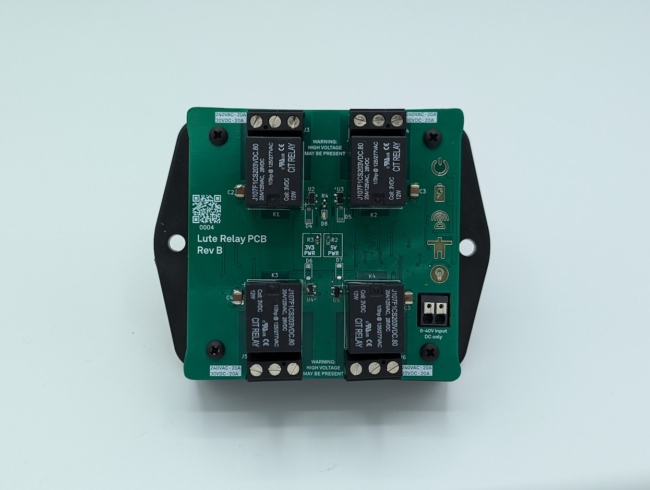When building IoT applications for a simple application space, it pays to build on top of already working systems. That’s the case for the hardware we’re showing today, the Aludel Lute Relay.
This design started as an experiment for a new form factor to plug into our Aludel Elixir Board. The unit has 4 relays capable of switching 20 amps AC or DC. This unit could be useful in remote physical access (i.e. locks), lighting control, or the application that inspired this design: smart lockers. Let’s dive into how this is built and how someone could use this latest Golioth Solutions Marketplace design to build a business.
New form factor
Control Power from Anywhere
This hardware is a great fit for applications where you want to remotely control power. The 4 relays on board and the large 5.08 mm pitch terminal blocks means you can safely pass high currents through the board. The traces on the relay are configured for creepage and clearance required for 240V. The relays being used are marked for 120V, but the datasheet says they are capable of 240V.
This application draws on my own experience building a simple smart locker using Golioth. I built it using an nRF9160-based dev board and then point-to-point wired a bunch of off-the-shelf power controls. It worked great, as the control requirements are low: nothing more than a GPIO is required for output. However, from a manufacturing capability and scaling to a larger fleet of devices, the wiring would have been a horrendous experience. The Lute Relay board codifies the ability to switch power and enables it in a much more compact package. In my case, I was passing 12V through the relays to a set of LED lamps inside the locker and to the solenoid controlling the door latch.
The relays truly are the easy part. The important piece in the system starts from the GPIO (controlling the relays) and goes all the way back to the cloud. The firmware is built on top of Golioth’s Reference Design Template. We trigger the various GPIOs within app_settings.c, which is triggered from the Golioth Settings Service. When we change the relay setting on the console, it gets pushed out from the Golioth service down to the device over CoAP, and then the Golioth Firmware SDK translates the packet and triggers the proper GPIO.
Made for extensibility, not durability
The Lute Form factor, like most of the devices in the Solutions Marketplace, is a starting point, not an off-the-shelf product. We intend for you to take these devices to prove an idea and then modify them for the specifics of your business. You can hire Golioth Solutions Services to help you with that, tap one of our wonderful Design Partners, or take on the task yourself.
What about future Lute boards? Well, the testing of this board has created a great starting point for future designs and applications. If you have one in mind, get in touch via our forum and let us know what you’d like to see us build next.
Watch the Livestream playback
We live streamed the entire creation flow of this board. You can watch it below.




No comments yet! Start the discussion at forum.golioth.io